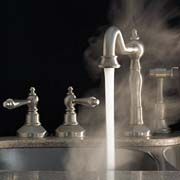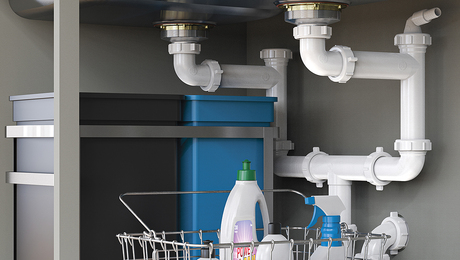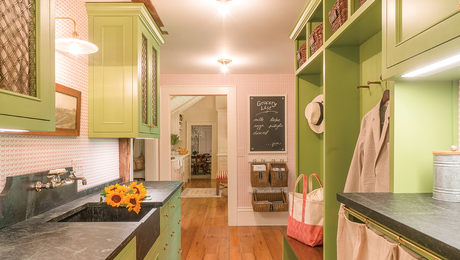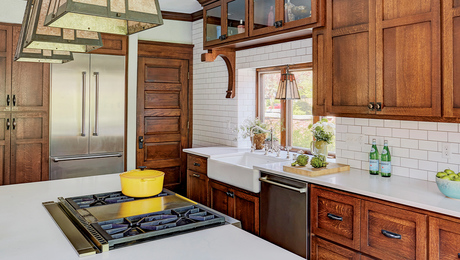A Debate Steeped in Hot Water
Do lower water-heating temperatures mean lower energy bills and safer delivery?

True or false: 120°F is a safe hot-water storage and/or delivery temperature?
Although manufacturers, industry agencies, and the media have lulled us into believing that turning down a water heater’s thermostat will save energy, let’s take a closer look at the facts.
For starters, a 120°F is not a safe delivery temperature. At 120°F, it takes only 80 seconds for a child to suffer a second degree burn and 3.1 minutes for a third degree burn; infants and the elderly can suffer second and third degree burns even more rapidly.
According to the American Hospital Association, more than 100,000 cases of scalding from hot water occur every year. The National Safe Kids Campaign indicates that more than 26,000 of these cases involve children and that an average of nine children die from scalding-related injuries yearly.
Unless your water heater is more than 20 years old, its thermostat was set at the factory for an average storage temperature of 120°F. However, these thermostats, while reliable devices that typically outlast the water heater itself, are not precise instruments. Additionally, settings that target 120°F often are not stable because thermostats allow stored water to cool by as much as 15°F before cycling to reheat. Checking your water heater’s delivery temperature at any given point of use yields a range of temperatures based on when the water heater last actively heated water.
There was a time when water heaters came set to store water at 140°F and dishwashers did not have internal heaters for a sanitizing rinse. It was widely recognized then that 140°F water was hot enough to kill bacteria. But scaldings led to lawsuits and a desire to increase energy efficiency caused manufacturers to remove temperature markings from thermostat dials. Most now read “vacation, warm, or hot.” With the storage temperature lowered to 120°F, and energy input (Btus) also reduced on gas-fired models, dishwasher manufacturers responded by adding heating elements to boost final rinse water to 140°F. Homeowners quickly discovered that the lowered storage temperature in their new water heater caused them to run out of hot water much sooner than when using their old unit, and they responded by turning up the dial from its warm setting toward, or all the way to, hot.
Admittedly, water delivered at 120°F is safer than water delivered at 140°F, but despite these changes, scalding, and lawsuits from scalding, continue. The ANSI (American National Standard Institute) Z21.10 regulations governing water-heater temperatures recognize that a phenomenon known as “thermal stacking” occurs in any hot-water storage vessel. As a result, a water heater’s stored-water temperature could be up to 30°F higher than its thermostat setting and be in compliance. Setting the thermostat to 120°F holds the potential of having water as hot as 150°F waiting to be delivered to a point of use at 150°F, a child could suffer third degree burns in 0.7-seconds. Turning the thermostat to its hot setting will instruct the water heater to maintain a temperature of approximately 160°F. By adding a 30°F thermal stacking effect, the water heater will deliver ANSI regulation-approved 190°F water to any faucet in your home.
Showerheads and other areas where legionella thrive
Several decades ago, little was known about hot-water bacterial amplification, and as a result, no one realized that lowering the storage temperature to 120°F would result in the creation of a breeding ground inside water heaters for bacteria, including legionella, the bug responsible for Legionnaires’ disease and Pontiac fever. Additionally, distribution piping and point-of-use outlets like showerheads (known as distal sites) became colonized with bacteria carried away from these water heaters.
Legionella thrive in environments where water temperatures are between 50°F and 131°F, and the pH is between 5.0 and 8.5. When stagnation occurs, and biofilms and/or sediment are present, bacteria roam freely and establish new colonies.
According to the Centers for Disease Control, thousands of people are infected by legionella every year, and community-acquired legionella-based Pneumonia (CAP) has a 5% to 15% death rate.
For the results of a study where water heaters cultured positive for legionella bacteria, visit www.legionella.org/100960699-1.pdf.
What is a safe hot-water temperature?
In my experience, the answer is 110°F, where thermal scalding takes hours to occur. However, because water stored at 110°F provides an ideal home for bacteria, three areas, or zones, must be addressed to ensure stable temperatures and system wide protection that ensures both health and safety. These three areas are point of source (water heater); the distribution network (hot-water piping); and point of use (where human contact occurs).
Point of source: Legionella bacteria can survive in water as hot as 131°F. To provide what’s called “heat pasteurization,” the temperature above which Legionella begin to die, the storage temperature must be above 133°F. At 140°F, the contact time required to kill most of the free-roaming legionella bacteria is 20 minutes. It would be prudent to raise the storage temperature to 140°F, but since the risk for scalding injury increases dramatically at 140°F, we’ll need to add an ASSE (American Society of Safety Engineers)1017 thermostatic mixing valve to regulate the outlet temperature. This practice also negates the thermal heat-stacking issues.
Distribution network: Knowing that all piping contains a layer of biofilms and that chlorine levels in potable-water systems have no effect on legionella bacteria, we need to set that ASSE 1017 thermostatic mixing valve for a delivery of 133°F minimum. Constant circulation and the elimination of any dead legs (piping that is capped off) would be a perfect addition because stagnation is eliminated. Low-wattage circulators, or gravity circulation, with well-insulated piping keeps energy losses to a minimum and water moving. At 133°F, we’re still within the scalding temperature range, so we’ll need to think about the next step.
Point of use: To a large extent, the safe-water-temperature answer depends on who will be in direct contact at the points of use, their overall health, their age, and the thickness of their skin. Infants, young children, and the elderly have thin skin that burns much more rapidly than the average adult. However, if the delivery temperature is set to deliver a maximum of 110°F at the point of use, everyone will be adequately protected.
Plumbing codes currently require the installation of an ASSE 1016 scald-guard faucet, but only for bathing facuets. Installing an ASSE 1016 listed (meaning it has been subjected to and passed independent testing) scald-guard faucet can provide protection from scalding if properly adjusted after its installation.
Three types of scald-guard devices
Currently, there are three types of code-approved ASSE 1016 scald-guard devices, which are classified as pressure-balance-only (P-only), temperature-reacting-only (T-only), and pressure-temperature (PT) valves.
The pressure-balance-only valves react to changes in pressure between the hot and cold lines but don’t react to water-temperature changes. As a result, the factory-set delivery temperature for a pressure-balance-only scald-guard device fluctuates, and municipal-water temperatures have been known to vary by as much as 50°F as the seasons change.
Delivery temperatures therefore can easily rise to temperatures where scalding can occur. Absent the ASSE 1017 valve (mentioned at length in the main article) at the water heater’s outlet, both thermal stacking as high as 190°F and adjusting the thermostat upward will allow scalding-hot water to slip right through a temperature-blind pressure-balance-only scald-guard device.
Our existing plumbing codes do not delineate between the ASSE 1016 P-only, T-only, and P/T devices. The cost disparity between the three is nominal, with P/T valves about $50 more expensive. In my opinion, it would be a wise move for our national plumbing codes to require that P/T valves be installed for all bathing modules. The remaining points of use could have P-only or T-only ASSE 1016 listed devices unless the user required additional P/T protection.
Do lower water-heating temperatures mean lower energy bills?
Turning your water heater’s thermostat to 120°F to conserve energy sounds simple, right?
On the surface, this statement makes sense. It sounds perfectly logical that lower storage temperatures would save energy. Let’s explore the idea that a 120°F water storage temperature indeed saves energy. If all you ever did with potable hot water were store it in some vessel, the heat loss to the surrounding space would invariably increase as you increase the difference between the storage temperature (delta-T) and that of the surrounding space. Insulation values and stack losses (for flue-style heaters) would be the determining factors alone, provided there was no thermo-siphoning or use of hot water. That’s why this notion is so believable.
But if we assume the adjusted bathing-module delivery temperature will be 102°F and that yearly incoming cold-water temperature averages 50°F, we can calculate costs associated with daily and yearly usage with 120°F or 140°F storage temperatures. We’ll give a fictional family of three each 15 minutes in the shower for a combined total run-time of 45 minutes at 2.5 gallons per minute. That’s 112.5 gallons per day or 41,062.5 gallons per year. To achieve the desired mix of 102°F for the bathing environment, we’ll need to determine the ratio (R) of hot to cold water. You can do this by subtracting the finished bathing temperature (BT) by the cold-water inlet temperature (IT), and then dividing that number by the storage temperature (ST) after subtracting the cold-water inlet temperature (IT), using the formula: R = (BT – IT) ÷ (ST – IT).
If the family’s water heater maintains its storage temperature at 120°F, the ratio looks like this: (102 – 50) ÷ (120 – 50) or 52 ÷ 70, which gives us a multiplier of 0.743. If you do the math for maintaining storage at 140°F, you’ll get a multiplier of 0.578.
Therefore,
41,062.5 x 0.743 = 30,509.4 galllons of 120°F water heated for bathing per year,
And,
41,062.5 x 0.578 = 23,734.1 galllons of 140°F water heated for bathing per year.
Based on these calculations, you would actually use more hot water annually when heated to 120°F. Let’s compare the costs to heat that water each year with a chimney-vented 50-gallon natural-gas water heater. On average, the overall energy efficiency, with stand by heat losses included, is 63% for this type of water heater.In late 2007, natural gas costs me $0.006224 per cubic foot. One cubic foot of natural gas contains 1,050 Btus, and it takes 1 Btu to raise 1 lb. of water 1°F.
Therefore,
The annual requirements to heat and store water at 120°F: 30,509.4 x 8.33 (lb. per gallon) = 254,143.3 lb. x 70°F rise in temp = 17,790,031 Btus ÷ 0.63% (efficiency) = 28,238,144.4 net Btus required each year. My annual cost to heat the water would be $167.38.
And,
The annual requirements to heat and store water at 140°F: 23,734.1 x 8.33 (lb. per gallon) = 197,705.1 lb. x 90°F rise in temp = 17,793,459 Btus ÷ 0.63% (efficiency) = 28,243,585.7 net Btus required each year. My annual cost to heat the water would be $167.42.
As I’ve demonstrated, turning down the thermostat to save money works only if you use the same number of hot-water gallons. Let’s say, for the sake of argument, that you use just 50 gallons a day no matter the temperature setting; you’ll take shorter showers or get used to cooler bathing temps. Your annual cost savings using the same gas-fired, chimney-vented, 63% efficient water heater will amount to a whopping $6.63.
As the idiosyncratic radio announcer Paul Harvey would say, “And now you know the rest of the story.”


























